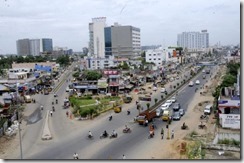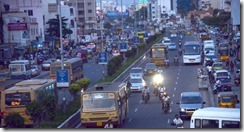Industry experts explain the deglamorization of OMR and that a revival might be in the offing
Building in Perungudi, Rajiv Gandhi Salai, OMR in Chennai – The Hindu
Rajiv Gandhi Salai (popularly called Old Mahabalipuram Road) was the great Chennai dream. The real estate growth around this 20 km stretch from Madhya Kailash junction to Siruseri was motivated by IT development, and hence its alternative name as the ‘IT corridor’. “OMR’s glorious period was between 2001 and 2008,” begins N. Nandakumar, president, Tamil Nadu, Confederation of Real Estate Developers Association of India (CREDAI). It was when developers, irrespective of pedigree and potential, flocked in with ambitious projects. “Every year, 10,000-12,000 units were being sold.” The rationale was that at least 10 per cent of the 1.5 lakh IT workers employed by companies on this stretch (including TCS, Cognizant, HCL, Ramco Systems etc) would want to buy property around the workplace.
A view of Old Mahabalipuram Road (OMR) in Chennai – The Hindu
The real problem, says Nandakumar, began when in the late 2000s, pan-India developers stepped in with their expansive projects. “Suddenly, the supply increased from around 10,000 to 30,000 units.” The recession did not help matters, and with job security not guaranteed, buyer sentiment hit a low. In the mid-2000s, people were able to buy property on OMR at Rs. 2,500 per sq.ft and sell it at double the price in just two-three years. Thanks to the over-supply that began in the late 2000s, such appreciation has come to a halt now. There is no question of prices reducing although, as he says “construction costs continue to rise. It is impractical to expect project prices to come down. There may be the occasional developer who wishes to cut down on losses by selling units at a reduced price, but they are the exceptions.”
Rajesh Babu, founder-director, RECS Group, a real estate consultancy firm, talks of another problem — the construction of luxury apartments. “These projects are unaffordable for the average buyer. Efforts should be taken to bring units here that are in the Rs. 40 lakh to Rs. 70 lakh range,” he says. Ananth Vummidi, managing director, BBCL, a Chennai developer that has two ongoing projects in Perungudi and Thoraipakkam, respectively, says OMR is not a high-end market. “Potential buyers are discouraged by properties selling for more than a crore. The mushrooming of luxury apartments on OMR is a corrosive trend.”
R. Kumar, chairman, CREDAI-Tamil Nadu, explains that the lull in IT development in this area has caused the target customer demographic to be restricted to the middle class and upper middle class. “Had the boom continued, top-level managers would have been hired and the profile of potential buyers elevated. But that was not to be,” he says. Where there is over-supply, it is crucial that buyers are lured with relevant projects. Price stagnation, affordability and connectivity problems on OMR have all conspired to make localities in west Chennai such as Kolathur and Ambattur more interesting for investors.
A view from OMR SRP Tools bus stop to OMR Kottivakkam, Rajiv Gandhi Salai – The Hindu
However, the lull is only temporary if the predictions of Nandakumar and Rajesh Babu are anything to go by. “There are encouraging signs since the new central government has come in,” says the former. “I notice a spurt in IT-related activity again, a precursor to real estate development.” Babu believes that with time, old stock will make way for more relevant, new stock that will push demand up again.
Perhaps the biggest development in the corridor is the proposed 1,500-acre township for Japanese investors in Thiruporur. “When this project gets completed in three years, the prices will begin to appreciate again.” Until then, established developers have to sit tight and ride the storm. Should the government policies continue to be investor-friendly, the popular notion is that OMR will be back in the reckoning.
Source: The Hindu Chennai



